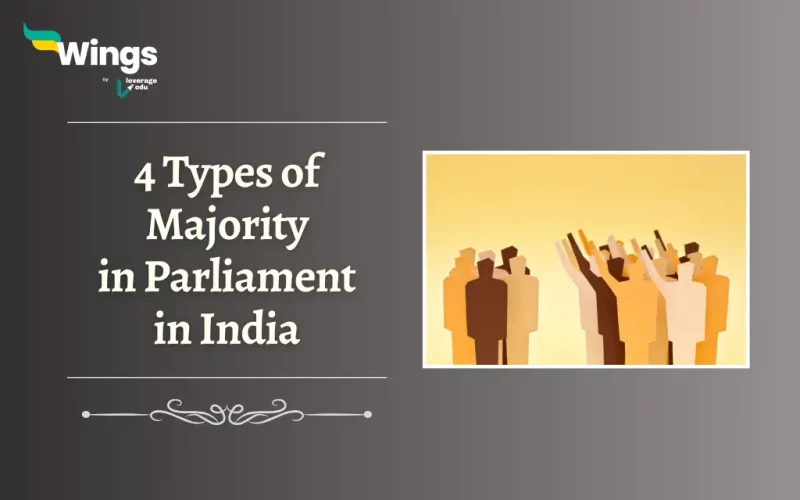In the Indian parliamentary system, the principle of parliamentary democracy is upheld through the concept of the “Majority in Parliament.” Moreover, with 545 members representing constituencies across India, the party or coalition securing over half of these seats holds significant sway. Additionally, this Majority position empowers the ruling party to form the Government, elect the Prime Minister, and drive legislative agendas. Read on to learn more in detail about the 4 Types of Majority in Parliament in India.
Types of Majority in Parliament
Furthermore, here are the 4 Types of Majority in Parliament:
1. Simple Majority
The majority needed in Parliament, as per Article 100 of the Indian Constitution, is the simple majority of members present and voting. This is also called Ordinary Majority, Functional Majority, or Working Majority.
In addition, certain situations require a Majority vote, including:
- Passing Ordinary, Money, and Financial bills.
- Voting on Adjournment, No-Confidence, Confidence, Censure Motions, and Motion of Thanks.
- Removing the Vice-President in Lok Sabha (Article 67).
- Approving the President’s Rule (Article 356).
- Endorsing a proclamation of Financial Emergency (Article 360).
- Electing the Speaker, Deputy Speaker of Lok Sabha (Article 93).
- Choosing the Deputy Chairman of Rajya Sabha (Article 89).
- Passing a Lok Sabha resolution to disapprove the continuation of National Emergency (Article 352).
Also Read: What is the Difference between National Emergency and President Rule?
2. Effective Majority
Additionally, in this Type of Majority, a Majority of the House means most of its members excluding any vacant seats.
- For instance, in the Rajya Sabha the effective majority is 111 out of 245 members with 25 vacant seats.
- Similarly, in the Lok Sabha, it is 265 out of 543 members when there are 15 vacant seats.
- This is termed as “a majority of all the then members of the House” in the Constitution. Moreover, it is required in these cases:
- Removal of the Vice-President in the Rajya Sabha (Article 67)
- Removal of the Deputy Chairman of the Rajya Sabha (Article 90)
- Removal of the Speaker and Deputy Speaker of the Lok Sabha (Article 94)
Also Read: Who was the First Rajya Sabha Speaker of India?
3. Absolute Majority
The majority in the House means the total membership present, regardless of vacant seats or absentees.
- For instance, in the Rajya Sabha, the absolute majority is 123 out of 245 members, and in the Lok Sabha, it is 272 out of 543 members.
- This type of majority is not specifically mandated by the Indian Constitution as a requirement but is needed in certain cases as part of a Special Majority.
Also Read: Why Do We Need Two Houses of Parliament?
4. Special Majority
Additionally, in this Type of Majority the different instances requiring a Special Majority can be further categorised as follows:
- Special Majority-I Most members of each House and two-thirds of those present and voting are needed in the following situations:
- Amendment of the Constitution (Article 368)
- Removal of Judges of the Supreme Court (Article 124)
- Removal of Judges of the High Courts (Article 217)
- Removal of the Comptroller and Auditor General of India (Article 148)
- Removal of the Chief Election Commissioner (Article 324)
- Removal of the State Election Commissioner (Article 243K)
- Parliamentary approval of the proclamation of national emergency (Article 352).
- Special Majority-II Two-thirds majority of each House is needed for the impeachment of the President (Article 61).
- Special Majority-III A two-thirds majority of the members present and voting in the Rajya Sabha is needed for:
- Recommending new All-India Services (Article 312).
- Passing parliamentary legislation on subjects in the State List (Article 249).
Related Blogs
Lastly, we hope you liked our blog and gained an understanding of the 4 Types of Majority in Parliament. Moreover, you may even read more blogs and empower yourself with knowledge regarding Civics and Polity!
 One app for all your study abroad needs
One app for all your study abroad needs













